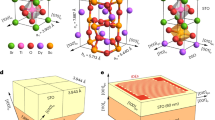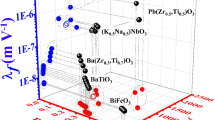Abstract
Systems with a ferroelectric to paraelectric transition in the vicinity of room temperature are useful for devices. Adjusting the ferroelectric transition temperature (Tc) is traditionally accomplished by chemical substitution—as in BaxSr1-xTiO3, the material widely investigated for microwave devices in which the dielectric constant (εr) at GHz frequencies is tuned by applying a quasi-static electric field1,2. Heterogeneity associated with chemical substitution in such films, however, can broaden this phase transition by hundreds of degrees3, which is detrimental to tunability and microwave device performance. An alternative way to adjust Tc in ferroelectric films is strain4,5,6,7,8. Here we show that epitaxial strain from a newly developed substrate can be harnessed to increase Tc by hundreds of degrees and produce room-temperature ferroelectricity in strontium titanate, a material that is not normally ferroelectric at any temperature. This strain-induced enhancement in Tc is the largest ever reported. Spatially resolved images of the local polarization state reveal a uniformity that far exceeds films tailored by chemical substitution. The high εr at room temperature in these films (nearly 7,000 at 10 GHz) and its sharp dependence on electric field are promising for device applications1,2.
This is a preview of subscription content, access via your institution
Access options
Subscribe to this journal
Receive 51 print issues and online access
$199.00 per year
only $3.90 per issue
Buy this article
- Purchase on Springer Link
- Instant access to full article PDF
Prices may be subject to local taxes which are calculated during checkout




Similar content being viewed by others
References
Vendik, O. G. Ferroelectrics for Microwave Applications (Soviet Radio, Moscow, 1979)
Lancaster, M. J., Powell, J. & Porch, A. Thin-film ferroelectric microwave devices. Supercond. Sci. Technol. 11, 1323–1334 (1998)
Hubert, C. et al. Confocal scanning optical microscopy of BaxSr1-xTiO3 thin films. Appl. Phys. Lett. 71, 3353–3355 (1997)
Devonshire, A. F. Theory of ferroelectrics. Phil. Mag Suppl. 3, 85–130 (1954)
Uwe, H. & Sakudo, T. Stress-induced ferroelectricity and soft phonon modes in SrTiO3 . Phys. Rev. B 13, 271–286 (1976)
Pertsev, N. A., Zembilgotov, A. G. & Tagantsev, A. K. Effect of mechanical boundary conditions on phase diagrams of epitaxial ferroelectric thin films. Phys. Rev. Lett. 80, 1988–1991 (1998)
Abe, K. et al. Modification of ferroelectricity in heteroepitaxial (Ba,Sr)TiO3 films for non-volatile memory applications. Integr. Ferroelectr. 21, 197–206 (1998)
Streiffer, S. K. et al. Observation of nanoscale 180° stripe domains in ferroelectric PbTiO3 thin films. Phys. Rev. Lett. 89, 067601 (2002)
Beach, R. S. et al. Enhanced Curie temperatures and magnetoelastic domains in Dy/Lu superlattices and films. Phys. Rev. Lett. 70, 3502–3505 (1993)
Gan, Q., Rao, R. A., Eom, C. B., Garrett, J. L. & Lee, M. Direct measurement of strain effects on magnetic and electrical properties of epitaxial SrRuO3 thin films. Appl. Phys. Lett. 72, 978–980 (1998)
Lock, J. M. Penetration of magnetic fields into superconductors. III. Measurements on thin films of tin, lead and indium. Proc. R. Soc. Lond. A 208, 391–408 (1951)
Sato, H. & Naito, M. Increase in the superconducting transition temperature by anisotropic strain effect in (001) La1.85Sr0.15CuO4 thin films on LaSrAlO4 substrates. Physica C 274, 221–226 (1997)
Bozovic, I., Logvenov, G., Belca, I., Narimbetov, B. & Sveklo, I. Epitaxial strain and superconductivity in La2-xSrxCuO4 thin films. Phys. Rev. Lett. 89, 107001 (2002)
Bednorz, J. G. & Müller, K. A. Sr1-xCaxTiO3: An XY quantum ferroelectric with transition to randomness. Phys. Rev. Lett. 52, 2289–2292 (1984)
Ang, C. et al. Dielectric polarization processes in Bi:SrTiO3 . J. Phys. Chem. Solids 61, 191–196 (2000)
Itoh, M. et al. Ferroelectricity induced by oxygen isotope exchange in strontium titanate perovskite. Phys. Rev. Lett. 82, 3540–3543 (1999)
Pertsev, N. A., Tagantsev, A. K. & Setter, N. Phase transitions and strain-induced ferroelectricity in SrTiO3 epitaxial thin films. Phys. Rev. B 61, R825–R829 (2000)
Hellwege, K.-H. & Hellwege, A. M. (eds) Landolt-Börnstein: Numerical Data and Functional Relationships in Science and Technology New Series, Group III, Vol. 16a, 59–64 (Springer, Berlin, 1981)
Hellwege, K.-H. & Hellwege, A. M. (eds) Landolt-Börnstein: Numerical Data and Functional Relationships in Science and Technology New Series, Group III, Vol. 11, 418 (Springer, Berlin, 1979)
Canedy, C. L. et al. Dielectric properties in heteroepitaxial Ba0.6Sr0.4TiO3 thin films: Effect of internal stresses and dislocation-type defects. Appl. Phys. Lett. 77, 1695–1697 (2000)
Hellwege, K.-H. & Hellwege, A. M. (eds) Landolt-Börnstein: Numerical Data and Functional Relationships in Science and Technology New Series, Group III, Vol. 7b, 26; Vol. 7e, 635 (Springer, Berlin, 1976)
JCPDS Powder Diffraction File: Sets 27 to 28 72 (Card 27–204, JCPDS International Centre for Diffraction Data, Swarthmore, 1986).
Chakoumakos, B. C., Schlom, D. G., Urbanik, M. & Luine, J. Thermal expansion of LaAlO3 and (La,Sr)(Al,Ta)O3, substrate materials for superconducting thin-film device applications. J. Appl. Phys. 83, 1979–1982 (1998)
Tidrow, S. C. et al. New substrates for HTSC microwave devices. IEEE Trans. Appl. Supercond. 7, 1766–1768 (1997)
Gevorgian, S. S., Martinsson, T., Linnér, P. L. J. & Kollberg, E. L. CAD models for multilayered substrate interdigital capacitors. IEEE Trans. Microwave Theory Tech. 44, 896–904 (1996)
Haeni, J. H., Theis, C. D. & Schlom, D. G. RHEED intensity oscillations for the stoichiometric growth of SrTiO3 thin films by reactive molecular beam epitaxy. J. Electroceram. 4, 385–391 (2000)
Christen, H.-M., Knauss, L. A. & Harshavardhan, K. S. Field-dependent dielectric permittivity of paraelectric superlattice structures. Mater. Sci. Eng. B 56, 200–203 (1998)
Lemanov, V. V., Sotnikov, A. V., Smirnova, E. P. & Weihnacht, M. Giant dielectric relaxation in SrTiO3—SrMg1/3Nb2/3O3 and SrTiO3—SrSc1/2Ta1/2O3 solid solutions. Fiz. Tverd. Tela (St Petersburg) 44, 1948–1957 (2002)
Hubert, C. & Levy, J. New optical probe of GHz polarization dynamics in ferroelectric thin films. Rev. Sci. Instrum. 70, 3684–3687 (1999)
Hubert, C., Levy, J., Cukauskas, E. J. & Kirchoefer, S. W. Mesoscopic microwave dispersion in ferroelectric thin films. Phys. Rev. Lett. 85, 1998–2001 (2000)
Acknowledgements
We acknowledge discussions and interactions with M. D. Biegalski, J. Schubert, S. Trolier-McKinstry and J. Mannhart during the course of this work. In addition, the financial support of the National Science Foundation, the Office of Naval Research for the work performed at NRL, the Swiss National Science Foundation, and, for the work performed at ANL, the US Department of Energy, Basic Energy Sciences—Materials Sciences is gratefully acknowledged.
Author information
Authors and Affiliations
Corresponding author
Ethics declarations
Competing interests
The authors declare that they have no competing financial interests.
Supplementary information
Supplementary Figure 1
Thickness dependence of the dielectric properties of strained SrTiO3 films. (PDF 481 kb)
Rights and permissions
About this article
Cite this article
Haeni, J., Irvin, P., Chang, W. et al. Room-temperature ferroelectricity in strained SrTiO3. Nature 430, 758–761 (2004). https://doi.org/10.1038/nature02773
Received:
Accepted:
Issue Date:
DOI: https://doi.org/10.1038/nature02773
This article is cited by
-
Electrocaloric effects at a phase transition created by strain
Nature Materials (2024)
-
Surface triggered stabilization of metastable charge-ordered phase in SrTiO3
Nature Communications (2024)
-
Quenched lattice fluctuations in optically driven SrTiO3
Nature Materials (2024)
-
Sub-nanometer-scale mapping of crystal orientation and depth-dependent structure of dislocation cores in SrTiO3
Nature Communications (2023)
-
Polarization in the van der Waals–bonded graphene/hBN heterostructures with triangular pores
Acta Mechanica (2023)
Comments
By submitting a comment you agree to abide by our Terms and Community Guidelines. If you find something abusive or that does not comply with our terms or guidelines please flag it as inappropriate.



